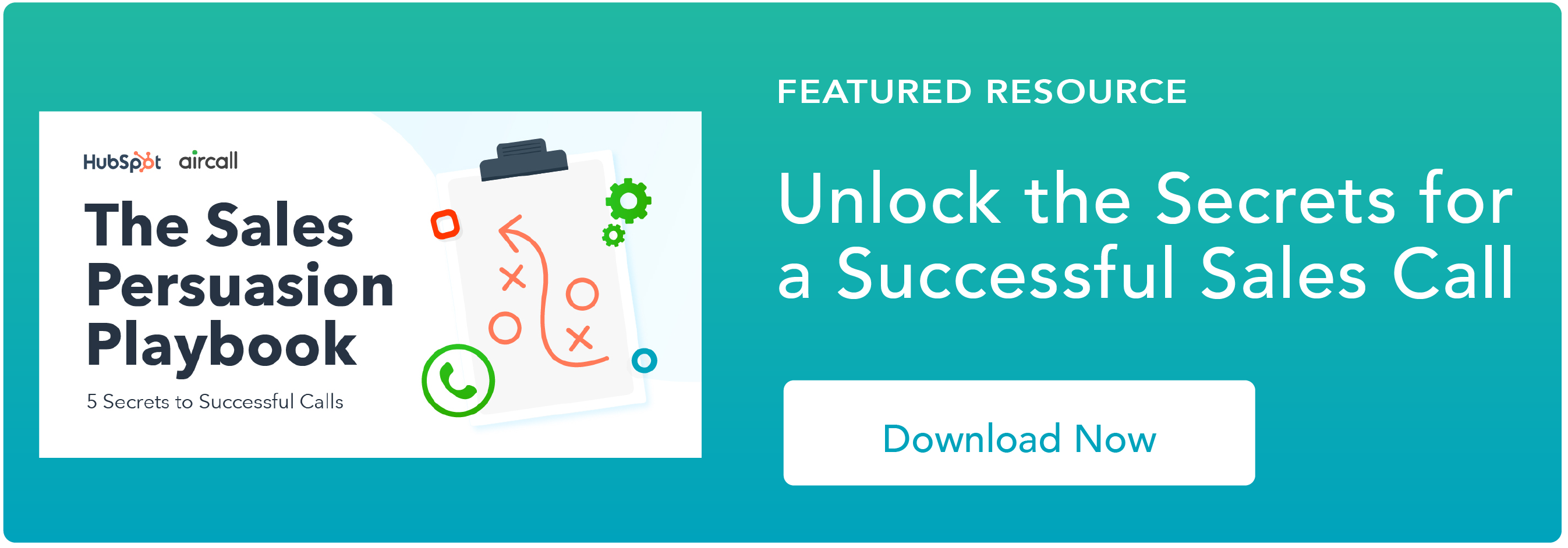For a salesperson, persuasion is the ultimate superpower.
How often do you get a call from a prospect you’ve never spoken to before who says, “I love your service and it’s the perfect fit for my business. Where do I sign?”
Probably not that often.That’s where persuasion comes in. Some deals are easier to close than others, but all sales conversations will involve some degree of persuasion -- even if both salesperson and buyer know your offering is the best choice.
It’s not easy -- if persuasion were simple, far more than one-third of all salespeople would make quota. But adopting the techniques below can make you more convincing, and influence prospects to buy.
This guide is divided into four sections. Use the table of contents below to quickly navigate to each:
1) Quick Tips
2) Conversational Pointers
3) Timeless Advice
4) Psychological Hacks
Important note: Salespeople should not sell prospects unless they're confident the product or service will benefit them. Persuading someone to reach a mutually beneficial goal is one thing. Lying is another. Don't cross the line.
Quick Tips: Persuasion Hacks
These four tips provide quick and easy ways to immediately boost your self-confidence and perceived authority.
1) Make the right amount of eye contact.
They say that eyes are the “windows to the soul” for a reason. Eye contact engenders a subconscious sense of connection. In a Cornell University study, researchers altered the eyes of the Trix cartoon rabbit on several boxes and then asked adults to choose one. Participants most frequently chose the box where the rabbit was looking directly at them.
How much eye contact is enough? According to body language expert Carol Kinsey Gorman, you should aim to make direct eye contact for 30% to 60% of your conversation.
2) Smile and dial.
You won’t always be able to meet prospects in person. So it’s a good thing we are remarkably sensitive to vocal intonation even when we can’t see the speaker’s face. One study even showed that we’re able to identify different types of smiles based on audio alone.
With this in mind, you’ll come across as more engaged and helpful if you smile during a conversation, and your prospects will be happier to talk to you.
Fun fact: Nestlé actually places a mirror at each salesperson’s station as a reminder to reps to smile while they dial.
Smiling can help your own state of mind as well. Research shows that even a forced smile decreases stress levels and makes you happier. So smile! It’s good for you, and people will respond positively to your enthusiasm and upbeat mood.
3) Use “power poses” to increase your confidence.
“Fake it ’til you make it” is oft-given advice, but does faking it actually help you achieve your goals?
According to psychologist Amy Cuddy's TED talk "Your Body Language Shapes Who You Are," it does. Cuddy conducted a study where she asked participants to stand in poses associated with high-power and low-power positions for two minutes.
Saliva tests revealed that the high-power group saw a 20% increase in testosterone levels, a hormone associated with confidence, and a 25% decrease in cortisol levels, a hormone associated with stress. The low-power group experienced a 10% decrease in testosterone and a 15% increase in cortisol.
When you’re confident, you inspire confidence in others. Your prospects don’t want to listen to a meandering, uncertain salesperson -- they’re looking for an authoritative guide who can lead them through a confusing purchasing process.
So the next time you want to instill trust, strike a pose. High-power poses include standing up straight with your hands on your hips, leaning back in your chair with your feet on your desk, or sitting with your legs and arms spread. Low-power poses include sitting hunched over or shrinking in your chair.
You can see more high-power and low-power poses in the recording of Cuddy’s TED talk on the subject, starting at 10:40.
4) Nod at your prospect.
Like smiling, the physical act of nodding is so associated with agreement that it has measurable effects on opinion. Research shows that people who nodded while listening to a radio broadcast agreed with the broadcast’s content more than people who shook their heads or made no head movements while listening.
Because humans naturally mimic each other, your nods will likely be contagious and prime your prospect to say yes.
5) Use your hands.
If you're meeting with the buyer face-to-face or over a web conferencing platform like Skype, use hand gestures.
"Emblematic gestures, such as the OK sign or extending two fingers to signal two, are particularly helpful in aiding memory," writes Richard O. Young, author of Persuasive Communication: How Audiences Decide.
One study found audience members remembered 34% of a message when the presenter used emblematic gestures, compared to just 5% when they didn't use any gestures.
Conversational Tips: What to Say and How to Say It
The number of words you say in a sales conversation represents the number of opportunities you have to win that deal, so make every word count. Use these tactics to make sure you’re communicating the right way.
6) Use your prospect’s name.
Remember that a person’s name is, to that person, the sweetest and most important sound in any language. -Dale Carnegie
You should know all your prospects’ names and the names of their businesses. If you don’t, learn them. (Memory not your strong suit? Try out HubSpot's free CRM to help keep track of all the prospects and deals you’re currently working.)
Not only is remembering (and using) your prospect’s name common courtesy, it also subtly reinforces your relationship and demonstrates that you respect them as a person, separate from your business dealings. It's the reason a personalized "Hi, [recipient's name here]" is becoming near ubiquitous in email marketing.
7) Sequence your questions strategically.
The best way to get somebody to agree with your argument is to make them think they thought of the idea first. That means understanding your prospect’s strengths and weaknesses as well as or better than they do, and asking questions designed to guide them to your proposed solution.
To do this, start with questions you know will be answered with a “yes.” This strengthens your prospect’s faith that you understand where they’re coming from, and gets them in the habit of agreeing with you. It also helps you build your case piece by piece, instead of having to stop and handle objections every five minutes.
Word your questions in a way that reinforces your product as the best choice. Instead of asking, “What’s the best way for you to improve [X part of your business]?”, emphasize the value of your product: “If you were to perform [X action enabled by your product] and it created [Y positive business result], would that be valuable for your team?”
A tip from the lawyers’ playbook: Once you’re past the initial discovery and solution-building stage of the sales process, avoid asking questions you don’t know the answers to. Instead, do enough upfront work so you know everything you need to know in order to anticipate and mitigate objections.
8) Mirror your prospect.
We naturally pick up the mannerisms and speech patterns of the people we spend a lot of time with. Why? It makes us more likable.
In one study, people were more likely to report positive feelings toward those who mirrored them. In addition, once a participant had been mirrored, they acted more favorably to people in general -- even those who hadn’t been involved in the initial conversation.
While you should stop short of blatant imitation, be attuned to your prospect’s behavior, and calibrate yours accordingly. If they seem timid, don’t overwhelm them with exuberance, and vice versa.
9) Affirm your prospect’s concerns and questions.
There’s no such thing as a stupid question. When your prospect raises objections or asks for clarification, use language like, “I see where you’re coming from,” and “That’s a great question” to reassure them that they’re being heard and respected.
10) Avoid putting prospects on the defensive with the Ransberger Pivot.
If a prospect misrepresents information you’ve provided or objects to one of your points, you have two options. You can respond with, “You’re wrong,” and put them on the defensive, or you can use the Ransberger Pivot to bring them around.
(Hint: go with the pivot.)
Developed in 1982 by Ray Ransberger and Marshall Fritz, the Pivot is a three-step technique designed to positively address disagreement:
- Listen to your prospect’s objections.
- Understand your prospect’s objections, or ask questions until you do.
- Find a common goal in your prospect’s objections and convince them that your solution is the best way to achieve those goals.
For example, if your prospect raises concerns about your lengthy onboarding process because they want to hit the ground running, acknowledge their desire to see results as soon as possible. Then point out that while you're fully supportive of their goals, they'll be able to better achieve the desired outcomes if they spend the initial time upfront to learn every facet of your product.
11) Avoid filler words.
According to a study from call analytics platform TalkIQ, steering clear of filler words like "um" and "like" can lead to longer sales calls.
"There was 30% less use of these words in longer calls than shorter calls," explains TalkIQ CEO and cofounder Yon Nuta.
Filler words make you sound less confident and credible. They're also distracting, especially if you use them so often the buyer starts anticipating when you'll say one next.
Luckily, there's a simple fix. Replace filler words with short pauses. Not only will you sound more self-assured, you'll also give your prospect more time to digest your message.
Timeless Advice: How to Win Deals and Influence Prospects
In 1938, Dale Carnegie penned the now classic book How to Win Friends and Influence People. In this section, we’ve taken some of Carnegie’s best tips and given them a sales-focused spin.
12) Appeal to the nobler motives.
Maybe your prospect wants to make enough money to hire an additional employee so they can get a raise, or look good to their boss. And your offering can help them do just that.
But framing the entire sale as a salary or promotion play won't get you very far. Even if you win over your contact, they certainly won't be able to secure buy-in from decision makers by emphasizing how this purchase will help their individual position.
“A person usually has two reasons for doing a thing: one that sounds good and a real one,” Carnegie writes. “All of us, being idealists at heart, like to think of motives that sound good. So, in order to change people, appeal to the nobler motives.”
With this in mind, figure out your prospect's real motivations for buying (or not), and repackage these intentions into a loftier cause.
13) Dramatize your ideas.
At its core, a closed-won deal is an exchange of money for a product or service.
Described this way, it sounds like one of the least interesting things in the world. But you know that a sale is more than that -- it’s the promise of better outcomes for both you and your customer, and describing it this way is far more inspiring.
At some point you're going to have to make a business case, but your conversations shouldn't exclusively focus on dollars and cents. Show your prospect what their business could be, and how your product will take them there.
14) Arouse an eager want.
A crucial part of winning people over, according to Carnegie, is to always appeal to what they want. Placing yourself at the center of a purchasing decision is the wrong strategy.
Instead, step into your customer’s world and tap into their motivations. If you do this right, you hand your prospect a sense of empowerment.
As Carnegie put it, “Customers like to feel that they are buying, not being sold.”
Psychological Hacks: Using Science to Your Advantage
Inspired by this infographic from Everreach, the following tactics use psychology to persuade.
15) Scratch your prospects’ back.
Why? Because they'll be more likely to scratch yours.
One study found that when waiters gave customers a complimentary mint, their tip increased 3%. Giving two mints saw a 14% increase. When the waiter left one mint, then turned around and said, “But for you nice people, here’s another mint,” his tip increased by 23%.
This is known as reciprocity. Going above and beyond for your prospects -- especially with a bit of theater -- will make them want to help you if they can.
16) Ramp up the urgency.
People want things that are scarce. If you’re offering a discount or something else that your company provides on a limited basis, let your prospect know. Also make sure they're aware of what they stand to lose if they don’t act soon.
17) Establish yourself as an expert.
It’s simple -- people trust people who know what they’re talking about. Signal to your prospects that either you or your company (ideally both) are highly knowledgeable in their industry.
18) Ask for a small initial commitment.
People who have said “yes” once are likely to say “yes” again. It’s why so many technology companies offer free trials. Laying the groundwork with small asks also moves prospects closer to the ultimate “yes” -- a signed contract.
According to Everreach, people hoping to persuade would be wise to first seek “voluntary, active, and public commitments in writing.” In this way, you hook your prospects little by little, which makes the big decision at the end seem like a natural and foregone conclusion.
19) Make your prospects like you.
Nobody likes helping people they dislike. In one study, two groups of MBA students were asked to come to a mock business agreement. One group was told to skip all pleasantries, while the other was asked to identify one similarity each student shared with their negotiating partner. Fifty-five percent of the group that got straight down to business came to an agreeable solution, but 90% of the group that took time to find common ground were able to do so.
Remember -- we’re all human. Establish a relationship with your prospect outside of the sale and your deal will likely be easier to close.
20) Use consensus to your advantage.
It’s not that we’re lemmings ... but we’re kind of lemmings. People look to others’ behaviors to determine what’s socially acceptable and how they should act.
You can leverage this by using testimonials and case studies from happy clients in your sales collateral. You can also reference your total number of customers or following on social media to emphasize your company’s wide reach.
But what if you only have one customer? Lean on reviews or assessments from industry experts. If you don't have impressive numbers as of yet, it's best to avoid them altogether.
21) Limit the number of choices you give your prospect.
It's far harder for humans to make choices if we're presented with too many options -- a study by Columbia Business School professor Sheena Iyengar found that while more variety draws us in, it fails to convert interest into purchases.
So be careful not to overwhelm your prospect. Even if your product comes in 37 colors or variations, start narrowing down that pool from the first conversation so you can present your prospect a much smaller, more manageable set of options.
Persuasion is a tricky skill to master. Changing someone’s mind isn’t an easy thing. But the right mix of the tactics above will get you at least one step (and hopefully many steps) closer to convincing your prospects you’re the sales rep they want to sign with.
Editor's note: This post was originally published in June 2015 and has been updated for comprehensiveness and accuracy.
Sales Strategy




.png)

![7 key sales challenges to prepare for in 2026 [+ how you can overcome them]](https://53.fs1.hubspotusercontent-na1.net/hubfs/53/sales-challenges-1-20251023-788058.webp)
![How B2C sales could shift in a recession [new data]](https://53.fs1.hubspotusercontent-na1.net/hubfs/53/Recession%20sales%20strategies%20(1).png)
![22 Best Sales Strategies, Plans, & Initiatives for Success [Templates]](https://53.fs1.hubspotusercontent-na1.net/hubfs/53/Best-Sales-Strategies-1.png)
![What Is Sales? A Quick Guide [+ Examples]](https://53.fs1.hubspotusercontent-na1.net/hubfs/53/what-is-sales-1-20250411-8755735.webp)

![What Is Cross-Selling? Intro, Steps, and Pro Tips [+Data]](https://53.fs1.hubspotusercontent-na1.net/hubfs/53/ft-cross-selling.webp)

